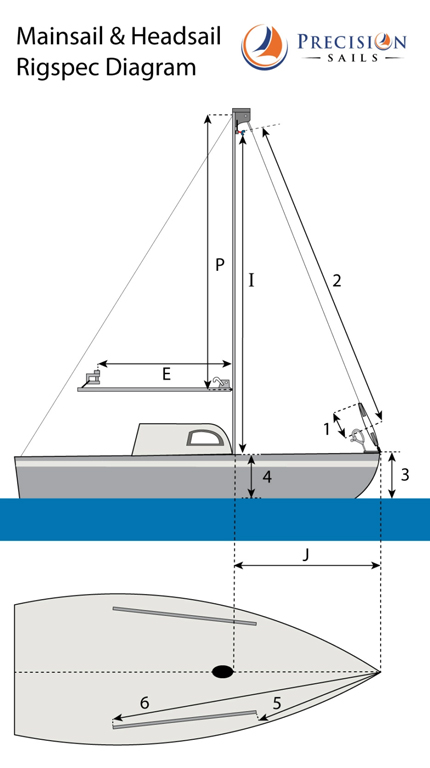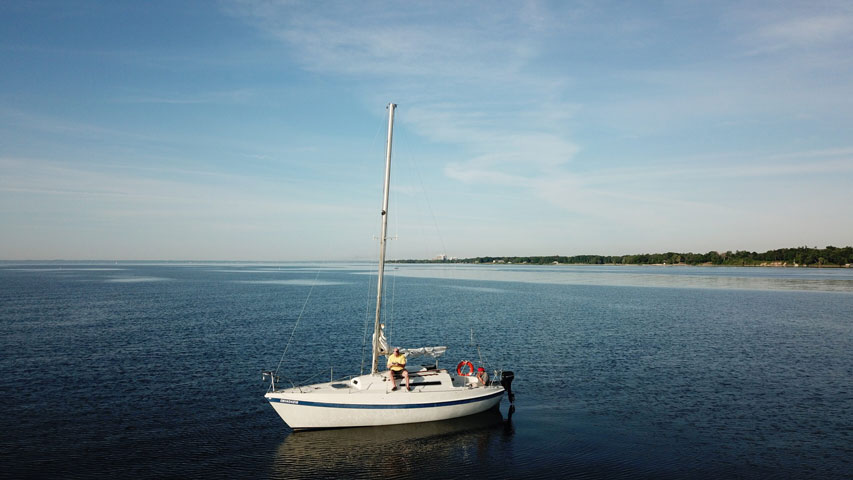Sailboat Rig Specs: Precision Sails Defined
The above infographic shows how Precision Sails label sailboat rig specifications. Continue reading below to see definitions and basic how-to tips on how to measure them below. Rig specs are important for designing a sail suited for your applications and boat. When you decide to get a custom sail from Precision, in most cases, you will be taking your own boats measurements. So it’s important to know about rig specs!
One thing we tell sailors here at precision is “The effort you put into measuring really does translate into the quality of sail you get” If quality measurements are given to designers, it allows them to create an excellent performing sail. It’s essential that good information is passed on to the designers when they create your sail.
The more information you can give to us, the better. One detail we strive to get right with sailors is the sailboats measurements. Taking your own sail boats measurements is an imperative part of creating a custom sail.
Photographs are also a handy tool. They let our designers understand your rigs better and can make suggestions and improvements.
Sometimes sailors think sails are like Lego, or the marine equivalent of a Honda Civic car part, where you can just swap out sails like its nothing. But this isn’t further from the truth. Sailboats are handmade. There can be many differences from one model to the next. Your boat might not be fresh out of the boatyard. It might be 36 or more years old, all this time equates to the boat changing, modifications being made, new parts being installed, break in periods, different maintenance intervals. There are a whole slew of reasons why your boat’s rig specs could be, and probably are, different from the next. This is the main reason we are so thorough with our measurement forms and design process.
Mainsail Rig Specs
P – Maximum Mainsail Hoist Length (Maximum luff): On the main halyard, hoist a measuring tape measure until it stops without jamming the halyard into the shiv. Measure straight down along the mast to the top of the boom at the tack. Disconnect Mainsail from Halyard. Be sure the boom is in the normal sailing position.
E – Maximum Foot Length: Measure from the aft face of the mast to the shackle of the outhaul. Make sure the outhaul is pulled back to it’s tightest position. When you get a maximum foot length we are not actually going to design the sail exactly to that length but rather a couple inches shorter. This allows you to adjust your outhull and not have your adjustments pushed against the shiv at the end of the boom, as well as changing tension in the sail.
Backstay Measurement: This measurement serves as a guide so we know how far the leech of your sail can be pushed without it overlapping the backstay. Sometimes you want this for certain performance reasons, but most cruisers do not want it to overlap, because it results in less wear.
Headsail Rig Specs
I – Foretriangle Height: Measure from the top of the halyard to the side deck on the forward side of the mast.
J – Foretriangle Base: Measure along deck from the forestay to the Forward face of mast. The J measurement is just a secondary check to make sure nothing has been changed over the years and there’s no surprises.
1. First Hank: Measure from tack to the first hank position on headstay wire above turnbuckle.
2. Maximum Luff Measurement: Measure from top of halyard to the bearing point of tack fitting
3. Waterline to Forestay: At the bow, measure the vertical distance from the waterline up to the intersection of the deck and forestay.
4. Waterline to Base: At the front of the mast, measure the vertical distance from the waterline up to the deck.
5. Headstay to Forward Track: Measure from tack attachment on deck to the forward edge of the headsail track you will be sheeting to.
Furling Head Sails
Headsail rig dimensions change slightly with a furling unit. The following videos do a good job of displaying the process of taking the measurements.
Furling drum height: Measure from the deck to the location of the tack attachment point on your furling drum. Measure the pennant separately.
After you get us your measurements. We will start customizing the design of your sail. There will be a consultation during the design process. We get you involved with this process because there are several things you can adjust for your sail – how far do you want the clew off the deck, where do you want the clew to sit and any thing else you might think of.
Put the knowledge you just gained into good use and take some good measurements! If you’re in need of a sail request a quote!




